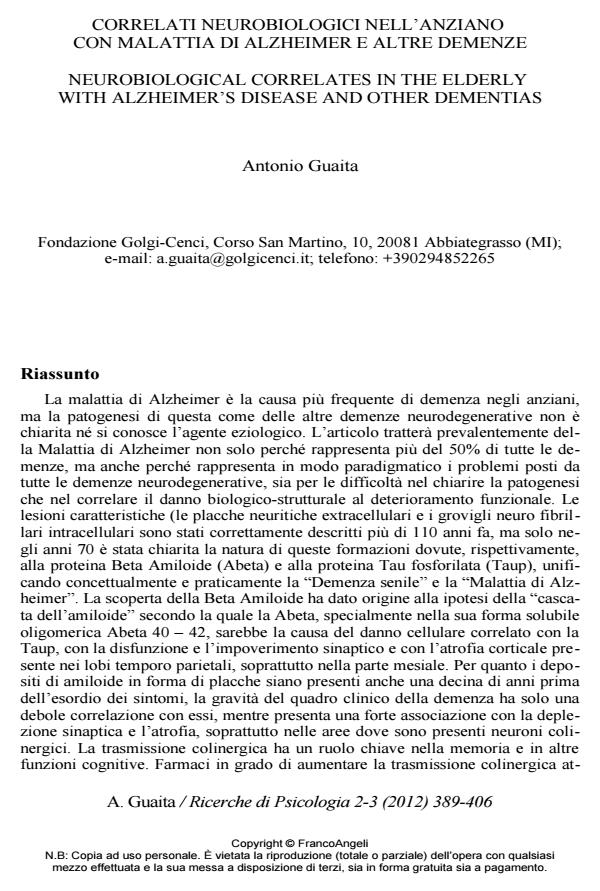Correlati neurobiologici nell’anziano con malattia di alzheimer e altre demenze
Titolo Rivista RICERCHE DI PSICOLOGIA
Autori/Curatori Antonio Guaita
Anno di pubblicazione 2013 Fascicolo 2012/2-3
Lingua Italiano Numero pagine 18 P. 389-406 Dimensione file 224 KB
DOI 10.3280/RIP2012-002016
Il DOI è il codice a barre della proprietà intellettuale: per saperne di più
clicca qui
Qui sotto puoi vedere in anteprima la prima pagina di questo articolo.
Se questo articolo ti interessa, lo puoi acquistare (e scaricare in formato pdf) seguendo le facili indicazioni per acquistare il download credit. Acquista Download Credits per scaricare questo Articolo in formato PDF

FrancoAngeli è membro della Publishers International Linking Association, Inc (PILA)associazione indipendente e non profit per facilitare (attraverso i servizi tecnologici implementati da CrossRef.org) l’accesso degli studiosi ai contenuti digitali nelle pubblicazioni professionali e scientifiche
La malattia di Alzheimer e la causa piu frequente di demenza negli anziani, ma la patogenesi di questa come delle altre demenze neurodegenerative non e chiarita ne si conosce l’agente eziologico. L’articolo trattera prevalentemente della Malattia di Alzheimer non solo perche rappresenta piu del 50% di tutte le demenze, ma anche perche rappresenta in modo paradigmatico i problemi posti da tutte le demenze neurodegenerative, sia per le difficolta nel chiarire la patogenesi che nel correlare il danno biologico-strutturale al deterioramento funzionale. Le lesioni caratteristiche (le placche neuritiche extracellulari e i grovigli neuro fibrillari intracellulari sono stati correttamente descritti piu di 110 anni fa, ma solo negli anni 70 e stata chiarita la natura di queste formazioni dovute, rispettivamente, alla proteina Beta Amiloide (Abeta) e alla proteina Tau fosforilata (Taup), unificando concettualmente e praticamente la "Demenza senile" e la "Malattia di Alzheimer". La scoperta della Beta Amiloide ha dato origine alla ipotesi della "cascata dell’amiloide" secondo la quale la Abeta, specialmente nella sua forma solubile oligomerica Abeta 40 - 42, sarebbe la causa del danno cellulare correlato con la Taup, con la disfunzione e l’impoverimento sinaptico e con l’atrofia corticale presente nei lobi temporo parietali, soprattutto nella parte mesiale. Per quanto i depositi di amiloide in forma di placche siano presenti anche una decina di anni prima dell’esordio dei sintomi, la gravita del quadro clinico della demenza ha solo una debole correlazione con essi, mentre presenta una forte associazione con la deplezione sinaptica e l’atrofia, soprattutto nelle aree dove sono presenti neuroni colinergici. La trasmissione colinergica ha un ruolo chiave nella memoria e in altre funzioni cognitive. Farmaci in grado di aumentare la trasmissione colinergica at- traverso l’inibizione della acetilcolinesterasi sono oggi in uso come trattamento sintomatico del deficit cognitivo. Oggi la neuro tossicita viene quindi ascritta alle forme solubili di Beta Amiloide, mentre le placche potrebbero essere interpretate anche come conseguenza, quasi un meccanismo di inattivazione e di difesa dalla tossicita oligomerica. Il danno vascolare puo di per se provocare demenza, ma ha un forte ruolo anche nella malattia di Alzheimer, dove pure sono sempre presenti anche danni vascolari di diversa gravita tanto che le due entita non sono spesso distinguibili. Altri tipi di demenza sono associati con la degenerazione Lobare Frontotemporale o con la deposizione di corpi di Lewy, ma in eta avanzata questi quadri non sono piu cosi distinti e le sovrapposizioni sono molto frequenti, sia cliniche che neuropatologiche, anche con il quadro neuro anatomico di persone senza demenza. Questo pone alla definizione dei correlati neurobiologici delle demenze degenerative problemi non solo tecnici ma anche di natura concettuale ed epistemologica.
Parole chiave:Demenza, malattia di Alzheimer, neuropatologia, beta amiloide, marcatori biologici.
Antonio Guaita, Correlati neurobiologici nell’anziano con malattia di alzheimer e altre demenze in "RICERCHE DI PSICOLOGIA " 2-3/2012, pp 389-406, DOI: 10.3280/RIP2012-002016